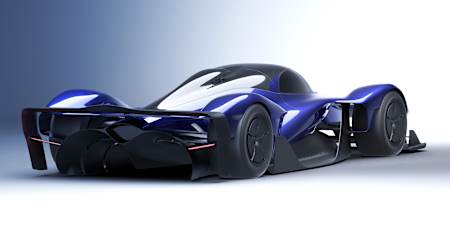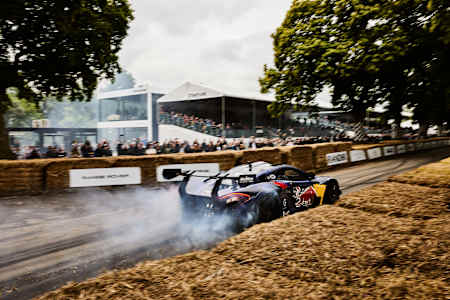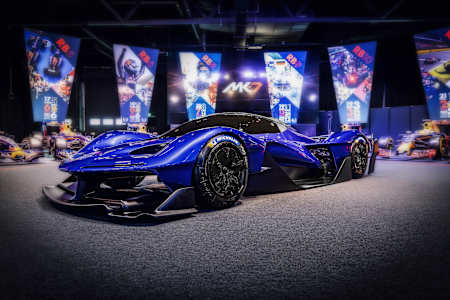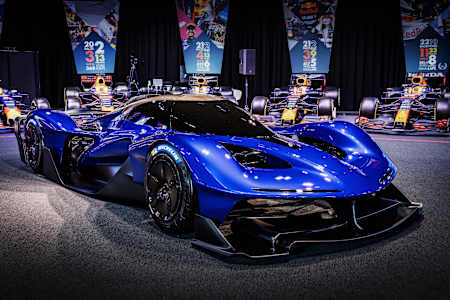Red Bull Motorsports

F1
What is a hypercar?
Understanding the pinnacle of automotive engineering.
The term “hypercar” conjures images of sleek, futuristic machines capable of breathtaking speed and unparalleled performance. They’re so desired that Red Bull drift racer Mad Mike Whiddett named his hypercar MADMAC, which made its debut at the Goodwood Festival of Speed.
“This is my craziest challenge to date, turning a custom Lanzante-built McLaren P1 GTR into the world's wildest drift hypercar — in only 100 days,” says Mad Mike.
But what is a hypercar? These high-performance cars represent the pinnacle of automotive engineering, blending luxury, cutting-edge technology, and sheer driving thrill. Let’s see just why it’s so exciting to watch the marvel of hypercars in action on the racetrack.
01
Defining a hypercar
Characteristics of hypercars
A hypercar is the best of the best of supercars. They’re distinguished by exceptional performance and speed, often exceeding 200 mph and sometimes reaching 300 mph. Hypercars accelerate from zero to 60 mph in less than three seconds, leaving an impression on even the most seasoned of drivers.
Mad Mike Whiddett drifting his MADMAC at Goodwood Festival of Speed 2024
© Eisa Bakos/Red Bull Content Pool
Hypercars don’t stop there. The engineering behind these vehicles is revolutionary, utilizing advanced materials like carbon fiber for lightweight yet strong structures. Typically, hybrid powertrains marry internal combustion engines with electric motors for strength and efficiency.
Hypercar vs. supercar
The terms hypercar and supercar are sometimes used interchangeably since hypercars make up a small fraction of supercars. However, they represent different tiers of high-performance vehicles. Supercars, such as the Lamborghini Aventador and the Ferrari SF90 Stradale, offer remarkable speed and luxury. Hypercars take these aspects to a new level. Hypercars surpass supercars in terms of performance, technological sophistication, and rarity.
The LaFerrari hypercar goes from 0 to 60 mph in 2.4 seconds with top speeds of 218 mph. In contrast, the Ferrari SF90 Stradale takes 2.6 seconds to reach 60 mph with a top speed of 217 mph. That extra 0.2 seconds of acceleration time might not seem like a big deal, but when drivers finish within milliseconds of each other, that extra speed can make the difference between placing first and not placing at all.
02
Top hypercar models
Iconic hypercars
A few names stand out in the world of hypercars, including:
- Bugatti Chiron: The Bugatti Chiron was released in 2016 and is the predecessor of the fastest production car from 2005. The Bugatti Chiron W16 engine surpasses the 250 mph standard and tops out at 304.77 mph with 1,578 horsepower.
- McLaren P1: This hybrid hypercar combines a twin-turbo V8 engine with an electric motor that’s capable of 903 horsepower. To make things more impressive, the McLaren P1 can go from 0 to 60 mph in 2.8 seconds.
- Ferrari LaFerrari: Described as Ferrari’s most ambitious project, the LaFerrari is the first production car to use a Formula 1-derived hybrid. Made for less than 500 people, it can reach 62 mph in 2.9 seconds.
- Koenigsegg Agera RS: The Koenigsegg Agera RS takes an extra 0.1 second to reach 62 mph, compared to the Ferrari LaFerrari at three seconds. Its horsepower, however, reaches an impressive 1,160.
Emerging hypercars
Multiple new hypercar models that push the boundaries of performance and technology were released this year. McLaren’s new hypercar, codenamed P18, will include F1-inspired design and have an output of over 1,000 horsepower. The latest Bugatti-Rimac hypercar was released in June 2024, continuing the company’s commitment to building hypercars with an electrified battery. Porsche also brings a new electric hypercar that has all-wheel drive and the potential to reach 1,700 horsepower.
Oracle Red Bull Racing continues to push boundaries, especially with the revolutionary new RB17 hypercar. Fans witnessed the unveiling of this jaw-dropping new hypercar during the Goodwood Festival of Speed. Hypercars are known to be rare, but with only 50 of this model being made, it’s one of the rarest of them all. The V10 engine provides over 1,200 horsepower and 15,000 rpm. It can drive lap times equivalent to those of F1, with a top speed of 217 mph. Certain key parts of this vehicle will be made by F1 suppliers for all 50 RB17 hypercars built in the Red Bull Advanced Technologies factory.
03
The technology behind hypercars
Advanced engineering
Hypercars prioritize aerodynamics, with designs optimized to reduce drag and increase downforce. Materials like carbon fiber and titanium are used extensively to ensure strength while minimizing weight. Hypercar technology also centers on environmental sustainability in the materials used to build these lean mean-speed machines.
The powertrains of hypercars are also masterpieces of engineering, often combining high-powered internal combustion engines with electric motors to deliver unmatched performance and efficiency.
Cutting-edge features
Hypercars also include driver assistance systems for safer and better driving, including collision avoidance systems, cruise control, and lane-keeping assist.
04
The market for hypercars
Buyers and collectors
The hypercar market is as exclusive as the cars themselves. Buyers are often individuals who value prestige, performance, and exclusivity. There’s always a limited number of these vehicles made — cars like the RB17 are even more exclusive than a typical hypercar. Collectors seek these vehicles because of the rare status of being an owner.
Investment potential
Hypercars’ limited production runs and iconic status often lead to value appreciation over time. Factors such as brand reputation, technological innovation, and the limited quantity make hypercar models instantly classic. They’re valuable assets that can appreciate in worth as a rare collectible.
05
The future of hypercars
Trends indicate that increased electrification and autonomous capabilities are not far off for hypercars. Electric hypercars are on the rise, with Porsche and Bugatti-Rimac moving to battery power without sacrificing power and performance for sustainability.. Advances in autonomous driving technology aim to make hypercars faster and more powerful. The RB17 is a prime example of what the future may hold when it comes to horsepower and speed.
The icon of ultimate performance and innovation
Hypercars represent the peak of automotive engineering, blending unparalleled performance, cutting-edge technology, and luxury. From their extraordinary speed and advanced materials to their exclusivity, hypercars are symbols of human ingenuity and aspiration. The evolution and innovation of hypercars will undoubtedly keep pushing boundaries, inspiring automotive enthusiasts and setting new benchmarks in the world of high performance.






